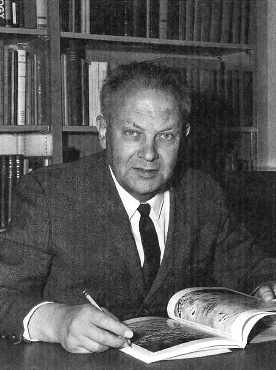Gerard Kuiper
Contents
[hide]Gerard Kuiper
(Lunar scientist)
Noted planetary scientist who revived interest in lunar studies in the early 1960's. The crater Kuiper is named after him.
Photo courtesy of Dennis Milon and Dr. Dale P. Cruikshank.
Lunar Work
- Founder Lunar and Planetary Laboratory .
- Served on nomenclature commission of the IAU
- Kuiper first took serious interest in the Moon in relation to his research on the theory of the origin of the Solar System - proposing that the planets formed by the condensation of a large gas cloud around the Sun. Recognizing that the moon's surface could hold information about the dynamic history of the terrestrial group of planets, he begun observing the lunar surface through the McDonald 82-inch telescope based on Mt. Locke, West Texas, in the mid-1950s. Including both visual and photographic evidence, Kuiper's study led to some extraordinary theories and results. Not all agreed with his findings, which, in a series of papers that appeared in the Proceedings of the National Academy of Sciences (see Bibliography below), he suggested that the Moon was 'once molten', that certain 'cracks' on the surface were due to impacts (e.g. the Hyginus rille and the Alpine Valley), that 'central peaks' in craters were non-elastic, non-rebounding, and that the 'origin of tektites' originated from the Moon. American physical chemist, H. C. Urey, responded some critique comments on Kuiper's findings, and the whole debate between the two swayed to-an-fro. Some of Kuiper's findings still prove very topical and controversial today, however, while his research concerning the lunar surface was of significant importance at the time, today it must be viewed in a new light as having added to better descriptions in those areas. Kuiper later went on to make serious contributions in the 1960s to the Ranger lunar probe program, and in the identification of landing sites for the Surveyor and Apollo missions. In addition to the lunar crater named after him, there also are Kuiper craters on Mercury and Mars, as well as a belt of asteroids, which extend beyond Neptune, named in his honour. - JohnMoore2
Where & When
Personal Information
Photos
- Kuiper and Whitaker
- Photographs of Gerard Kuiper and other lunar scientists in NATIONAL GEOGRAPHIC, February 1969, pages 212 and 213 (Moon men).
Birth
Dec 7, 1905, Harenkarspel, Holland
Death
Dec 23, 1973, Mexico City
Education
Publications
- Photographic Lunar Atlas
- Kuiper, Gerard P.; Middlehurst, Barbara M. (eds) (1963) The moon, meteorites and comets. The Solar System, Chicago: University of Chicago Press, 1963.
Additional Information
- Wikipedia Article
- Anecdotes (see also Whitaker, 1985 link on LPL page)
LPOD Articles
Bibliography
- Cruikshank, D. P. (1993). Gerard Peter Kuiper 1905 - 1973 - A Biographical Memoir by Dale P. Cruikshank from the National Academy of Sciences 1993.
- Sagan, Carl (1974) Obituary Gerard Peter Kuiper (1905-1973). Icarus, Volume 22, Issue 1, pp. 117-118. 1974.
- Whitaker, E. A. (1974) G. P. Kuiper, 1905 December 7 - 1973 December 24. Physics Today, Vol. 27, No. 3, p. 85 , 87. 1974.
- Whitaker, E. A. (1974) Kuiper Archive. Science, Volume 184, Issue 4143, p. 1231.
- Kuiper, G. P. 1955. The Lunar Surface - Further Comments - Proceedings of the National Academy of Sciences, Vol.41, No.11, 820, 1955.
- Urey, H. C. (1955). Some Criticisms of "On the origin of the Lunar Surface Features" by G. P. Kuiper - Proceedings of the National Academy of Sciences, Vol.41, No.7, 423, 1955.
- Kuiper, G. P. (1954). On the Origin of the Lunar Surface Features - Proceedings of the National Academy of Sciences, Vol.40, No.12, 1096-1112, 1954.